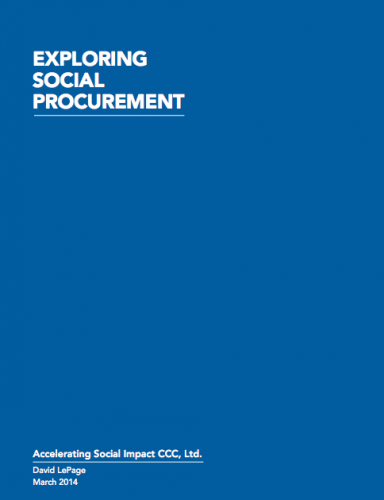The Purpose of the Report
Exploring Social Procurement examines an innovative market-based opportunity to create social impact through existing purchasing. The recent Federal Budget recognized that government alone couldn’t solve the complex social issues facing our communities. We would add, that alone no single sector, not the private sector and not the non-profit sector, could solve our current complex social issues. Together though, blending business values and social impact objectives through social procurement offers some hope.
Download the report
Background
Trading goods and services has existed for ages as a means to share resources, solve issues of scarcity, and create value. “Whoever thought that outsourcing, public-private partnerships and risk management were new principles? Actually the Romans created some very interesting features for their contracts that we still observe in some way today.” Business evolution in the 19th and 20th century emphasized economic value and more complex supply chains. The dominant priorities for purchasers were to meet the product quality requirements, at the lowest possible price, and avoid risk for the company.
The 1970’s saw a significant added pressure on purchasing, the environmental movement. Over the last 40 years environmental considerations have become integrated into procurement processes and decisions. The 1990’s saw two further influences on purchasers: Corporate Social Responsibility (CSR) and escalating social needs. CSR on the demand-side meant the use of broader “sustainability” criteria in corporate and government purchasing. On the supply-side innovative businesses that prioritize social impacts emerged, they were called social enterprises. These are the foundations for social procurement.
If successful, the potential benefit of social procurement, addressing complex social issues with existing purchasing, is enticing. However, the environmental scan and interviews for this report found that the perceived and real barriers to change the current culture, policy and practice of procurement create a significant challenge to capturing the opportunity and will require targeted efforts to be overcome.
TABLE OF CONTENTS
- Executive Summary 2
- The Purpose of the Report 2
- Background 2
- Recognition of Our Collaborators and Partners 4
- Process and Methodology for the Report 5
- The History of Purchasing 6
- Social Procurement Evolution 7
- What is Social Procurement? 8
- Benefits of Social Impact Procurement: 10
- Key Purchaser Issues 15
- Key Supplier Issues 16
- Recommendations: 17
- Key Recommendations for Purchasers 19
- Key Recommendations for Suppliers 21
- Steps to Implementation 22
- Implications for Governments and Others 23
- Creating Guidelines 25
- Conclusion 27
- Appendices 28
- Appendix A – Summary of Opportunities, Barriers and Recommendations 28
- Appendix B – Report Contributors: Key Informants, Focus Group Participants 30
- Appendix C – Summary Key Informant Interview Responses 32
- Appendix C1 – Purchasers 32
- Appendix C2 – Intermediaries 34
- Appendix C3 – Suppliers 36
- Appendix D – Summary of Barrier and Recommendations identified by Key Informants 37
- Appendix E – Focus Group Discussions 38
- Appendix F – Literature Review Works Cited and Reviewed;
- Relevant Web References; Footnotes 40





